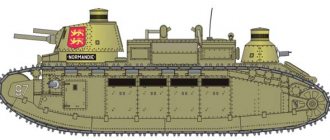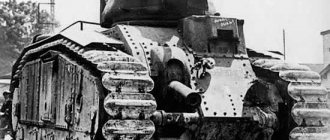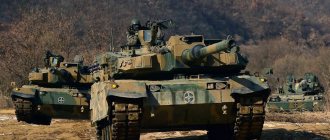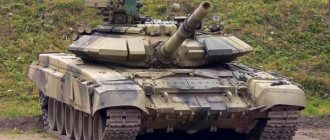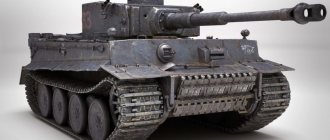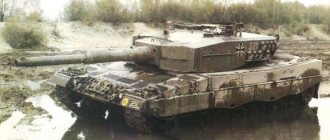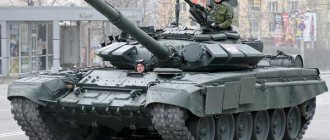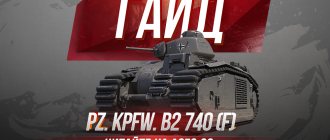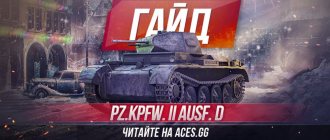Author: SerDiTyi
05 May 2022 12:11
Community: Igromir
Tags: May 9 e100 Germany victory day details about the tank history of tanks about the tank tanks
5721
6
4
development history, main characteristics, advantages and disadvantages
In the final period of World War II, Nazi Germany devoted a lot of effort and resources to creating several advanced weapons for its time. Among such developments, a special place is occupied by the super-heavy tank, called the E-100. This combat vehicle was part of a whole series under the symbol “E”, which included six models of tanks and self-propelled guns. Like other “miracle weapons” of the Third Reich, this tank had some truly breakthrough characteristics, but they were outweighed by a general critical mass of shortcomings, including those that turned out to be insurmountable for the designers. The E-100 tank was never completed even at the prototype stage.
Development history
Special research groups were involved in the development of new types of armored vehicles in Germany. One of them, led by the chief designer of the tank weapons testing department of the Wehrmacht Arms Directorate, Heinrich Ernst Kniepkamp, was formed in May 1942. Her work was based on the designer’s personal initiatives, supported by the study of experience in the combat use of previously created combat vehicles. The development of the E-100 tank by the Kniepkamp group started in July 1943. It was held in the city of Friedberg, at the design and production base of the Adlerwerke company. It should be noted that work on the creation of new super-heavy tanks in the Third Reich was actually duplicated due to long-standing competition among tank builders. Parallel development was carried out by Ferdinand Porsche's company, whose super-heavy tank was called Maus. In conditions of an acute shortage of raw materials, Hitler in 1944 ordered the curtailment of such developments, but with regard to the E-100 tank, the Fuhrer’s order was not carried out. Albeit at a slow pace, work on the car continued until the stage of a pre-production prototype. The only prototype of a super-heavy tank was manufactured at the Henschel plant.
0
See all photos in the gallery
By early 1945, the unfinished structure of the giant tank consisted of a hull, chassis and power plant. In this form, it was prepared for testing, and they intended to replace the tank turret, which was not ready at that time, with a mass-dimensional mock-up. A few months later, the pre-production E-100 prototype, which was still not equipped with all the equipment necessary for the prototype, was captured by British units advancing across Germany.
Design Bureau of E. Kniepkamp
In the spring of 1942, a research bureau was organized in Germany under the leadership of E. Kniepkamp, whose task was to design new types of tanks and self-propelled guns, taking into account the experience of use during the past period of the war.
The creation of the group was initiated by Kniepkamp himself, but the progress of the projects was difficult due to the fact that a massive part of the funds was allocated to work on the creation and modernization of military equipment in accordance with the requirements of the Wehrmacht. But, despite the limited resources, the designers managed to get results.
The developers defined the rules that were used in the design of military equipment.
Emphasis in the design bureau was placed in favor of increasing the level of armor protection to maximum values, increasing ammunition capacity and standardizing the components of military equipment. So the transmission elements and the engine should be placed in the rear of the armored vehicle.
The height of the activities of Kniepkamp's bureau began quite late - in the second half of World War II, at a time when the Axis countries began to suffer defeats on all fronts.
German E-series line
The development of E-series combat vehicles in Germany was determined by the competitive struggle of design teams. The project, whose name comes from the German word “Entwicklung” (“development”), is notable for the fact that it put forward the idea of unifying components and assemblies of promising combat vehicles. After the first years of the war, the presence of several separate branches in the development of armored vehicles had a negative impact on its production and maintainability.
In addition to the idea of unification, promising armored vehicles reflected replacement and improvement options for existing models, taking into account the accumulated experience of their combat use. As part of the German E-series, the index of the vehicles included in it was based on their estimated minimum weight.
0
All cars in the new series were initially intended to be rear-wheel drive, with a single power unit and transmission unit located in the rear of the structure. Most of the E-series combat vehicles did not advance beyond the early design stage until the end of the war. Against this background, the E-100 super-heavy tank turned out to be the most developed model.
Use in combat conditions of World War II
The fact that the E-100 tank was not brought to the stage of production of the finished vehicle allows us to talk about the possibilities of its combat use only from a purely theoretical point of view. Germany, suffocating from a lack of resources, could not bring such a project into reality, despite the fact that even the mass production of super-heavy tanks could not change the course and natural outcome of the Second World War.
The main task of the E-100 tank, like heavy vehicles like it, is to push through the direction chosen for an attack or counterattack. But in any case, the super-powerful tank had to require support. In close combat, he is not only almost useless, but also extremely vulnerable.
This technique is completely unsuitable for rapid attacks and breakthroughs. A firefight at medium distances with an outnumbered enemy also cannot be effective, primarily due to the long reload time of the gun. In fact, only in long-range firefights could the E100 tank provide a fairly successful final result of the battle with the enemy.
The fate of the real unfinished pre-production model of the E-100 tank after its capture by British troops was generally short and sad. In the summer of 1945, the car was transported to Great Britain, where, after a careful, but not very long study, it was cut into scrap metal a few years later.
Profile of the E-100 tank in the World of Tanks simulator
The inglorious end of the Nazi giant left a memory only for a narrow circle of historians and individual specialists. The situation changed with the beginning of the 21st century, when tanks of the Third Reich became the subject of popular computer games. In this regard, the developers of the World of Tanks game were able, by introducing into their simulation characteristics as close as possible to reality, to give the German E-100 tank a virtual “second life”, which turned out to be very successful. The tank did not become a particularly effective combat vehicle here either, but received some positive aspects of recognition as a rather serious weapon of the Third Reich.
Frame
0
The hull, like the turret of the combat vehicle, was designed with armor plates inclined at 50-60 degrees, which increased their resistance to enemy shells. The corps was divided into three sections according to the classic German scheme. The control compartment, located in the front, provided space for the driver and radio operator. The fighting compartment occupied the middle part of the hull, on which a massive turret was mounted.
Characteristics of the role-playing system
There are 5 of them in total: strength (affects the damage your hero inflicts in battle, necessary for wearing weapons and armor), magic (affects your mana reserve and the ability to use more powerful magic), agility (affects the armor class (AC), accuracy, necessary for using weapons, mainly bows), vitality (affects the life of your hero).
One unit of magic adds 1 unit to the maximum mana reserve for a warrior and archer and 2 units for a mage. One unit of vitality adds 1 unit to the maximum life reserve for a mage and archer and 2 units for a warrior. AC should not be underestimated, it may be better to equip an item with a higher AC than one with better abilities.
Tower (equipment)
The turret of the super-heavy German tank was an independent development of the German concern Krupp. Initially, it was intended to be common to the design of both the Maus and the E-100. This tower in the Krupp company received the designation Mausturm II and in the course of further work in relation to the E-100 it was a significantly lightweight version with a design weight of 35 tons. The weight reduction was supposed to be achieved by reducing the thickness of the side armor to 80 mm and using a 128 mm gun instead of a 150 mm one. A full-scale model of the tower was never made. It is known that the turret ring, originally supposed to be no less than 3 meters, was reduced to 2600 mm.
Armament
In the history of the real E-100 prototype, it never came to the point of installing weapons, although the question of which combat modules to install on this vehicle was worked out for a long time. Developers from the Krupp concern envisaged as many as three main gun options for equipping the super-heavy tank, including a self-propelled gun version with a 173-mm cannon. The 128 mm KwK 44 L/55 gun was intended to be the original version, originating from an anti-aircraft gun of a similar caliber. In addition to it, the 75-mm KwK44/1 L/70 gun was intended to destroy infantry outside cover and weakly protected enemy vehicles. The ammunition capacity of 128 mm caliber shells was 50 rounds, and 100 rounds of 75 mm caliber shells.
KwK 44 L/38 cannon and machine gun
It was decided to make the 150-mm KwK 44 L/38 tank gun the main armament of the serial E-100. It was precisely this version of the main caliber gun for super-heavy tanks that Hitler insisted on. Even in the early period of World War II, the Krupp company was able to produce a 150-mm gun with an initial projectile speed of 600-800 m/s, based on a railway platform. But all attempts to adapt their design for tank weapons were unsuccessful. >> It also turned out to be impossible for the Krupp concern to finalize the integration of a single German MG34 machine gun into the E-100 tank turret. The 7.92 mm MG42 machine gun was intended only for transportation in the tank.
Design
The design of the E-100 was carried out according to the standard German scheme: with the engine placed aft and the transmission mounted in the frontal part. The armor of the tank was given great importance: the front of the hull had armor 200 mm thick with rational angles of inclination of the upper sheets of 600 and the lower sheets of 500.
The sides were protected by an armor plate 120 mm thick, and additionally installed external screens further increased the armor protection.
The rear armor was 150, the bottom of the tank was reinforced with armor plates 80 mm thick. The weight of the E-100 was supposed to be about 140 tons.
The E-100 tower project had three options. The first option involved the installation of a Maus turret, the second option, called Mausturm II, was manufactured at the Krupp plant with 80 mm armor plates installed at an angle. The third option remained unknown, since the tower drawings were destroyed and the tower model was not released.
During the development of the tank, several weapons projects appeared. Initially, it was planned to install a KwK 44L/55 cannon with a caliber of 128 in the turret; later it was decided to increase the caliber of the gun and install a 150 mm KwK 44L/48. A second turret with inclined armor plates was developed for this weapon. True, after modifications the guns were able to mount a 150 mm artillery system in the Maus turret. The possibility of mounting a 173 mm caliber KwK 44 artillery system on a prototype was considered.
The crew consisted of 6 people, with a driver, radio operator, commander in the hull and two loaders with a gunner in the tank turret.
When designing the tank chassis, the heavy weight of the vehicle was taken into account. We had to abandon the standard scheme using torsion bars and install Belleville springs. Installing springs was quite expensive, although it not only saved space on the tank’s hull, but also simplified the possibility of carrying out repair work in the field, especially compared to serial Panzerwaffe heavy armored vehicles.
To reduce the specific pressure of the tank on the ground, it was planned to install tracks whose width was 1000 mm, which made it possible to reduce the pressure to 1.4 kg/cm2. However, the dimensions did not allow the E-100 to be transported by rail, since the size of the platforms did not allow for loading the vehicles.
For transportation by rail, special tracks with a width of 550 mm were installed on the E-100. The installation and dismantling of the tracks took a lot of time and caused a lot of inconvenience.
The E-100 was planned to be equipped with a Maybach HL 230P30 power plant with a power of 700 hp, with further replacement by the Maybach HL234, whose power was already 1200 hp. According to the developers, the power plant allowed the E-100 to accelerate to 40 km/h. But the engine project never went into production, although the power was also not enough for the 140-ton giant. Fuel consumption was 1000 liters per 100 km.
Chassis
The enormous weight of the heavy German tank dictated a special approach to the development of its chassis. The solution used in the E-100 was made by designers from MAN and was subsequently recognized as one of the most successful elements of this entire project. Although the suspension ended up being more complex and expensive to manufacture, which, given the shortage of resources experienced by Germany, became a serious obstacle to the creation of the tank. The chassis of the vehicle had 8 rollers with a diameter of 900 mm on each side as a support. The guide wheels were located at the front, the drive wheels at the rear, using tooth gearing. As with all heavy German armored vehicles, two versions of tracks were provided: transport tracks with a width of 55 cm and combat tracks with a width of 100 cm. Meter tracks made it possible to reduce the specific pressure on the ground to 1.4 kg/sq. cm.
Engine and transmission
The power unit of the prototype was a 12-cylinder Maybach HL-230 P30 gasoline engine with a power of 700 hp. in combination with Maybach OG 401216B gearbox. The power of such an engine was clearly not enough for a gigantic 140-ton machine. It was intended to install a Maybach engine with an index of 234 and an estimated power of 1,200 “horses” in future production models of the E-100, but it was only theoretically possible to organize the production of such engines in Germany in 1945. In the struggle to reduce the tank's excess weight, the designers were forced to abandon the torsion bar suspension. A new external suspension system based on Belleville springs has reduced rollover parameters. The car received a combined transmission; the final drives were very compactly placed in the engine compartment, which made access to them more convenient. The absence of torsion shafts also made it possible to install escape hatches for the crew in the bottom of the tank.
Advantages and disadvantages
Among the advantages of the super-heavy German tank E-100, experts noted: * The strongest frontal armor protection; * Strong armor on the sides due to the sufficient thickness of the sides of the turret and armor screens; * Successful suspension design; * Serious impact characteristics of the main gun; * Availability of a fairly effective auxiliary weapon. At the same time, the shortcomings of such a combat vehicle were very significant. Only the main ones are: * Huge weight; * Limited mobility; * Weak dynamic characteristics of the motor; * Insufficiently protected turret forehead; * Low turret rotation speed; * Long reload time for the main weapon. >> In general, the complex of shortcomings of the E-100 significantly outweighed its impressive, but not so numerous, advantages.
Plot
Let's get back to the plot.
The tasks you come across change. That is, you may come across a butcher, or maybe a king of skeletons (this is the missing king Leoric). In a network game you will need to destroy both of them. But the main quests remain. Killing the traitor Lazar will lead you to the lair of the main enemy, but he will be in .
Open the levers one at a time, otherwise you will most likely be killed. Diablo was in Albrecht's body, the soul stone stuck into Albrecht's forehead, your hero sticks it into his forehead.
The hero is naively trying to keep the demon within himself, but I will say in advance that he will not succeed; anyone who has played Diablo II will understand me.
